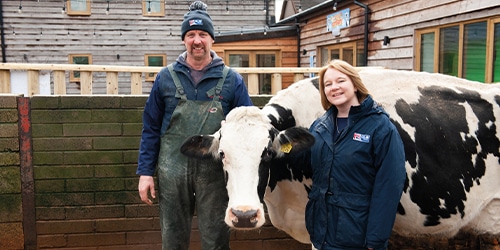22 Jan Actisaf® maintains rumen function during changes in diet

Diet changes and forage variability are inevitable parts of any dairy business, often leading to digestive upset, acidosis and subsequent losses in milk production which often go unseen. However, these negative effects can be avoided by focusing on how we manage diet changes and by optimising the rumen environment.
Martyn Smith is herd manager at Churchfields Farm where he milks a closed herd of 100 pedigree Holstein cows on 250 acres, including some tillage, in Droitwich, Worcestershire. The year-round calving herd are turned out to grass in spring and graze at least 180 days per year.
When housed, the herd’s diet is calculated for maintenance plus 25 litres fed down the trough, and cows are topped up to yield with GLW Feed’s Ruby 18 concentrate in the parlour, containing high levels of starch to complement this year’s more fibrous forage. Dry matter intakes from forage are at 15-16 kg/head/day, with total dry matter intakes at 24-25 kg/head/day. While grazing, cows are strategically fed buffer feed to maintain performance and to cope with variable grass availability.
In its fifth generation of ownership, Churchfields Farm has recently diversified to include a farm shop, café, child play centre, and ice cream parlour. They also produce Droitwitch Salt on site, made from a brine spring beneath Droitwich – the only of its kind in the UK.
Visitors can easily watch cows in the shed and milking parlour, both of which are located adjacent to public areas. The arrangement is a direct result of the Farm’s commitment to showcasing British dairy farming in a positive way and educating consumers about how milk is produced.
Cows are milked twice daily, and annual 305-day yields are at 9,000 litres with 4.3% fats and 3.44% protein, with around 4,000 litres coming from forage. This excellent performance does not come at the expense of fertility – Martyn’s herd boast an average calving interval of 383 days.
The majority of milk supplies the farm’s Arla 360 contract. Some of the milk is also sold direct to the public through a vending machine on site or used to produce the farm’s own ice cream.
“We believe in quality over quantity in most aspects of the business, but especially when it comes to the cows. Genetics are selected to produce good milk constituents rather than just higher yields, and we aim to keep inputs low,” explained Martyn. “I prefer to keep protocols simple and I’m critical of products that we use.”
Since taking over management of the farm in 2014, he has focused on developing a simple system based on good quality forage, focused breeding, proper nutrition and keeping stress levels low. This ensures a content herd of cows producing high quality milk, all while keeping expenses like veterinary costs low.
The herd’s health and welfare are top priority, with routine checks by the vet every two weeks keeping treatment needs to a minimum. Martyn’s proactive approach to is paying off with SCC levels at 80-150 and bactoscan count of 9.
“Our focus on producing high quality forage is really paying dividends. We feed a 50/50 grass and maize silage for most of the year and buffer feed as needed when grazing. As maize is such a crucial part of the diet, we would ideally have a supply year-round. But because of the lack of land available in this area, we have not had quite enough maize for the last few years and had to feed green maize for a period in the autumn,” he said.
“The cows struggled to manage that change, and we had problems with displaced abomasums and acidosis. We decided to have Actisaf added into a bespoke blend from GLW Feeds and saw improvement almost immediately.”
Martyn’s wife Lyn is a ruminant technical support at GLW Feeds and believes that Actisaf plays a key role in supporting the herd through diet changes. “Actisaf is included in the wagon at a rate of up to 8 g/head/day, keeping rumen function steady with no setbacks through diet transitions. It’s a critical tool for Martyn in maintaining milk production with our forage challenges and it fits into this system well.”
“We added Actisaf again for a second year with the green maize and left it in our ration for good after that,” Martyn concludes. “In the two years since, we’ve had zero displaced abomasums and no incidents of acidosis – I would definitely think twice before taking it out of our diet!”







Sorry, the comment form is closed at this time.